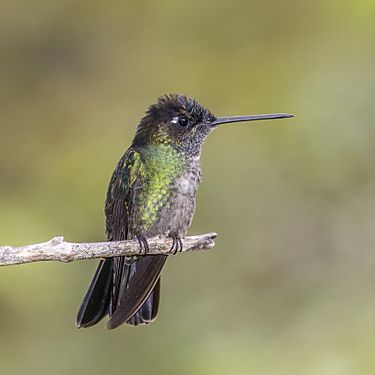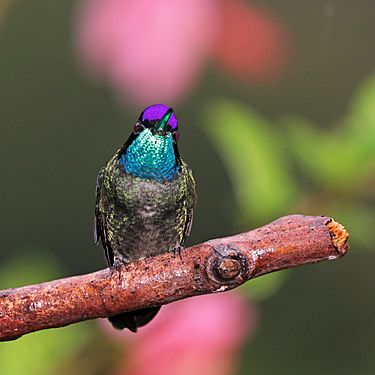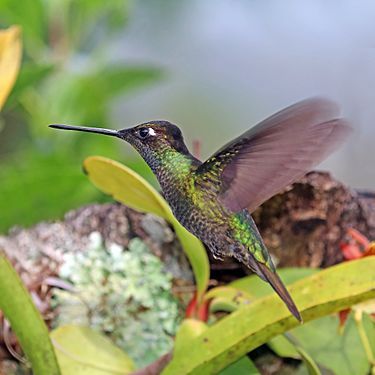Talamanca hummingbird facts for kids
Quick facts for kids Talamanca hummingbird |
|
|---|---|
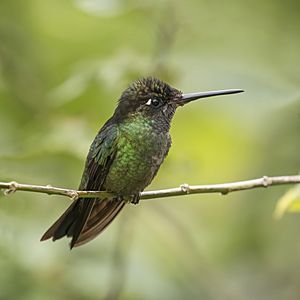 |
|
| Male | |
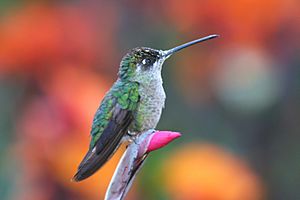 |
|
| Female | |
| Conservation status | |
|
LC (IUCN3.1 (See Status section))
|
|
| Scientific classification | |
| Genus: |
Eugenes
|
| Species: |
spectabilis
|
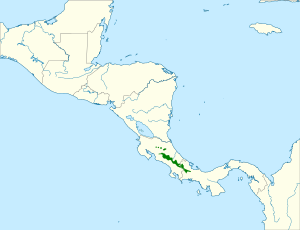 |
|
The Talamanca hummingbird (Eugenes spectabilis) is a beautiful bird found in the mountains of Costa Rica and Panama. It is also sometimes called the admirable hummingbird. This tiny bird belongs to a group of hummingbirds known as "mountain gems."
Contents
About the Talamanca Hummingbird
A Unique Species
For a long time, scientists thought the Talamanca hummingbird was just a type of another bird, the magnificent hummingbird. But starting in 2017, many bird experts decided it was different enough to be its own unique species. This means it has its own special name, Eugenes spectabilis.
Physical Description
The Talamanca hummingbird is about 13 centimeters (5 inches) long. Males are a bit heavier than females. Both male and female birds have a long, straight black beak. They also have a small white spot right behind their eye.
Male Hummingbirds
Adult male Talamanca hummingbirds are very colorful. They have a dull black forehead that shines with a dark green color. Their crown (the top of their head) is a bright metallic violet-blue or purple. The back of their neck and upper back are dull black.
Much of their face is dark green, and the area between their eyes and beak (called the lores) is deep black. The rest of their upper body and tail are a shiny bronzy-green or golden-green. Their chin and throat (called the gorget) are a bright metallic bluish-green. Their chest and belly are dark bronzy-green, mixed with brownish-gray on the belly.
Female Hummingbirds
Adult female Talamanca hummingbirds do not have the super shiny crown and throat like the males. Their upper body is a dull dark green, and most of their face is a sooty black color. The two feathers closest to their body on their tail are dull dark green. The other three tail feathers are bronzy-green with a black band near the end and brownish-gray tips.
Their throat is brownish-gray with buff-colored tips on the feathers. Their sides are dark green. Their chest, belly, and the feathers under their tail are a dull brownish-gray with a hint of dull green.
Young Hummingbirds
Young Talamanca hummingbirds look a lot like the adult females. However, their underparts are a darker brown and look a bit scaly with dull buff colors. The feathers on their upper body, especially on their head and neck, have buffy edges.
Where They Live and What They Like
The Talamanca hummingbird lives in the mountains of central Costa Rica and western Panama. In Costa Rica, you can find them in the Cordillera Central and Cordillera de Talamanca mountain ranges. In Panama, they live only in the Volcán Barú area.
These hummingbirds prefer to live in oak forests. They especially like the edges of these forests and open areas. You can also find them in nearby forests that are growing back after being cut down (called secondary forests). In Costa Rica, they live from about 2,000 meters (6,600 feet) up to the treeline. They are most common above 2,500 meters (8,200 feet).
Hummingbird Behavior
Movement and Travel
Talamanca hummingbirds usually stay in one place. However, some birds might move to lower areas during certain times of the year. This could be a regular migration for them.
What They Eat
Talamanca hummingbirds mostly eat nectar from many different kinds of flowering plants. Male hummingbirds often protect patches of flowers in the lower parts of the forest. They sometimes also feed high up in the treetops. Female hummingbirds find food by flying a regular path, visiting a series of flowering plants.
These birds probably also eat small insects and spiders. The Rivoli's hummingbird, which is a close relative, catches insects while flying or picks them off plants while hovering.
Reproduction and Nests
In Costa Rica, the Talamanca hummingbird's breeding season is from November to March. Scientists don't know much about their breeding season in Panama yet.
They build a cup-shaped nest using soft plant fibers and other fine materials. They cover the outside of the nest with moss and lichens. The nest is usually placed at the end of a hanging bamboo stem, about 1.5 to 3 meters (5 to 10 feet) above the ground. We don't know how long the eggs take to hatch. But we do know that baby hummingbirds stay in the nest for at least 25 days after hatching.
Sounds They Make
The Talamanca hummingbird's song is a soft, low-pitched sound. It's like burbling, scratchy, and buzzing notes all together. When they are fighting with other birds, they make a fast stream of high, clear, liquid chirps. Another sound they make is a rather rough, rolling "nrrt" or "drrk."
Conservation Status
The Talamanca hummingbird is currently listed as a species of "Least Concern" by the IUCN. This means that its population is not in immediate danger. Even though its exact population size is unknown, it has a large area where it lives, and its numbers seem stable.
The Talamanca hummingbird is quite common in the areas where it lives. However, like many animals, it can be affected by the loss of its habitat. This happens when forests are cut down or changed. Luckily, there is still a lot of forest left in the Cordillera de Talamanca mountains, which helps protect these beautiful birds.
Gallery
See also
 In Spanish: Colibrí de la Talamanca para niños
In Spanish: Colibrí de la Talamanca para niños


